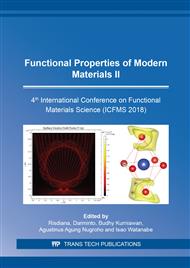p.404
p.409
p.415
p.422
p.428
p.433
p.437
p.444
p.451
Energy Storage Characteristics of Electrochemically Deposited Graphene Oxide on ITO and Cu Substrates
Abstract:
Graphene Oxide (GO) is two dimensional material that has been widely studied as an electrode material for supercapasitor. We prepared thin films of GO on metal oxide substrate of indium tin oxide (ITO) and metal substrate of Copper (Cu) using electrochemical deposition technique from 0.5 mg/ml GO dispersed in water. ITO-GO film was prepared using voltage range of -1.6 V to 0 V (ITO) and Cu-GO film was prepared using voltage range of 0 V to 1 V at scan rate of 50 mV/s. Both samples were characterized using Cyclic Voltammetry (CV) measurements in 1 M KCl electrolyte at varied scan speed with platinum (Pt) as counter electrode and Ag/AgCl as reference electrode. We compare energy storage characteristics of ITO-GO and Cu-GO using cyclic voltammogram data. It is found that GO deposited in metal substrate of Cu has higer energy density compare to that deposited in metal oxide substrate of ITO.
Info:
Periodical:
Pages:
428-432
Citation:
Online since:
August 2019
Keywords:
Price:
Сopyright:
© 2019 Trans Tech Publications Ltd. All Rights Reserved
Share:
Citation:


